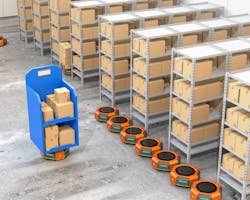When most young job seekers think about warehousing jobs, they picture traditional facilities where products are stored, picked and packed by hand. In these manual warehouses, employees usually work long hours doing repetitive and labor-intensive tasks, such as loading and unloading delivery trucks, traveling up and down aisles to pick orders, stacking heavy boxes, and moving pallets around the warehouse. All the while, everyone is under constant pressure to work fast since their speed and physical endurance are what keep orders moving out the door.
This constant bending, stretching, reaching and lifting puts significant stress on the human body, which makes workers more prone to injury. While injuries might start out small (e.g., sprains, strains and pulled muscles), some lead to chronic conditions and lifelong pain.
And ergonomic risks aren’t the only concern. Workers need to stay on high alert to avoid injuries from heavy machinery or hazards like falling loads. They may also have to deal with harsh environmental conditions. Pickers in cold storage facilities, for instance, brave freezing temperatures to pick products for customer orders.
So, when it comes to filling open positions, the talent pool is limited to those willing and physically able to take on such demanding work. The problem is, hiring and retaining qualified warehouse workers is one of the top challenges for companies, particularly as order fulfillment demands are increasing and labor pools are shrinking.
Robots in the Warehouse
How can companies better attract job seekers from a wider talent pool? One of the best ways is to focus on improving employee safety and working conditions. Here, automation can make a major impact.
Robotic solutions can take over the repetitive, labor-intensive processes involved in order fulfillment. Automated solutions—able to run 24/7 with minimal human involvement—can rapidly and accurately move products from receiving and storage through picking and dispatch. All movements are precisely controlled by intelligent software for optimal material flow and maximum throughput—even when demand spikes or labor is scarce.
A wide range of automated technologies are available today, so every warehouse can find a solution suitable for its unique product handling needs. That flexibility and customization contributes to a safer working environment. Some possibilities include:
- Order picking solutions that can handle everything from full pallet layers to crates to individual cases.
- Automated storage and retrieval systems (AS/RSs) that can move products in and out of high-density storage areas with ease.
- Automated guided vehicles (AGVs) that can safely and efficiently transport bulk inventory between various stages of fulfillment.
How Automation Benefits Employees
Automated order fulfillment solutions, when appropriate to the situation, help enable warehouses to run with speed and efficiency. In the process, they also create workplaces that attract and satisfy employees. Here are five ways that automation can provide a safer and more worker-friendly environment:
1. Reduced ergonomic risks. With robots doing the heavy lifting, employees don’t have to perform all those strenuous, repetitive tasks. However, if manual picking is still required for certain products, automation can make the process as ergonomically friendly as possible.
In a goods-to-person setup, for example, automation brings products directly to employees at ergonomically designed picking stations. Products arrive in plastic totes, crates or bins positioned at an optimal height and angle, enabling workers to pick the required products with speed and ease.
2. Fewer environmental hazards. Automated storage, retrieval and picking solutions operate in completely contained environments, which keeps employees well out of danger. Staff no longer have to work in close proximity to heavy machinery, look out for fast-moving forklifts or worry about heavy falling loads from precariously stacked pallets.
Automated solutions also free employees from spending time in harsh conditions, including the storage and picking areas of a cold storage facility or in the heat of an outdoor loading bay.
3. A diverse workforce. While labor-intensive roles are limited to those who can physically perform the job, automation enables warehouses to bring on a much more diverse range of employees. Job seekers of any age, gender and physical ability can excel in the tech-focused roles made possible by automation.
4. Alignment with personal values. As younger generations enter the workforce, companies must remember that these job seekers see work as much more than a paycheck. They also want to work for a company that aligns with their personal beliefs and values. In a 2022 Deloitte study of Gen Z and millennial employees, nearly two in five said they have rejected a job based on their personal ethics.
One of the most important values young jobseekers consider is sustainability. And warehouse automation can help companies to reduce their environmental impact in many ways. For example, automated solutions can run in a lights-out environment where all robotic movements and product flow are optimized for energy efficiency. Potential and existing employees prefer to work for a company willing to invest in sustainability.
5. New and engaging roles. There are many misconceptions about automation taking jobs away from people. But the reality is that automation opens up a whole new set of better job opportunities. Automated warehouses, though less reliant on manual labor, still need people to operate, supervise and maintain the robotic systems. Other emerging roles may focus on the software side of things, such as analyzing performance data for optimization opportunities.
These types of jobs are tech-focused and engaging—exactly what the younger generation of job seekers look for in a career. Of course, these positions will require new skills. Some automation providers offer hands-on training during implementation and beyond, so all employees are well-versed and comfortable working with the new technology.
Creating the Workplace of the Future
In the short term, automation can fill any existing gaps and ensure warehouse operations won’t be hindered by labor shortages. In the long run, automation will help companies build a strong workforce of the future, where skilled employees use technology for optimal performance.
It’s a win-win for companies and employees alike when job safety and satisfaction take priority.
Adam Gurga is national manager of grocery and retail partnerships with Cimcorp, a provider of intralogistics automation solutions.

